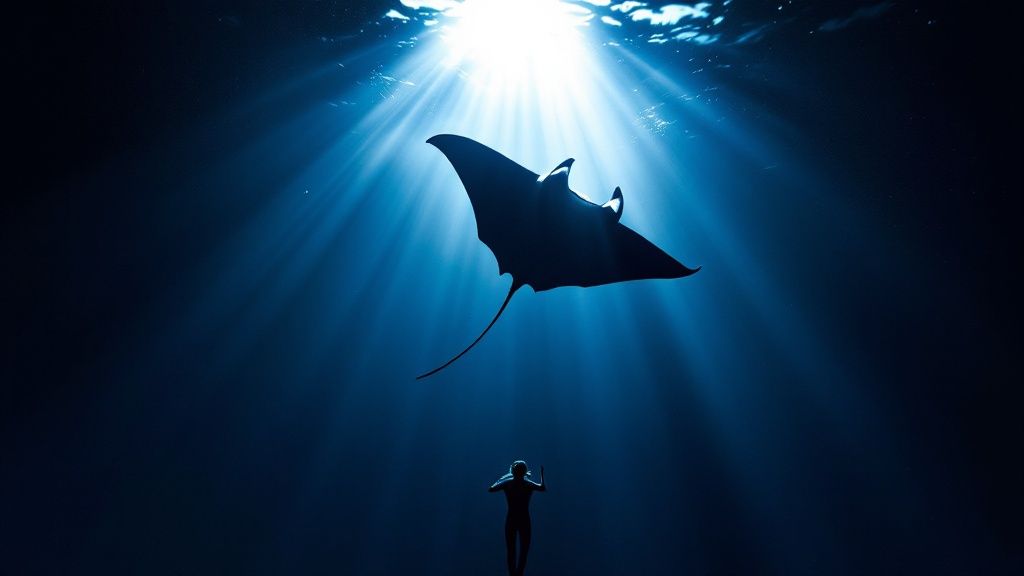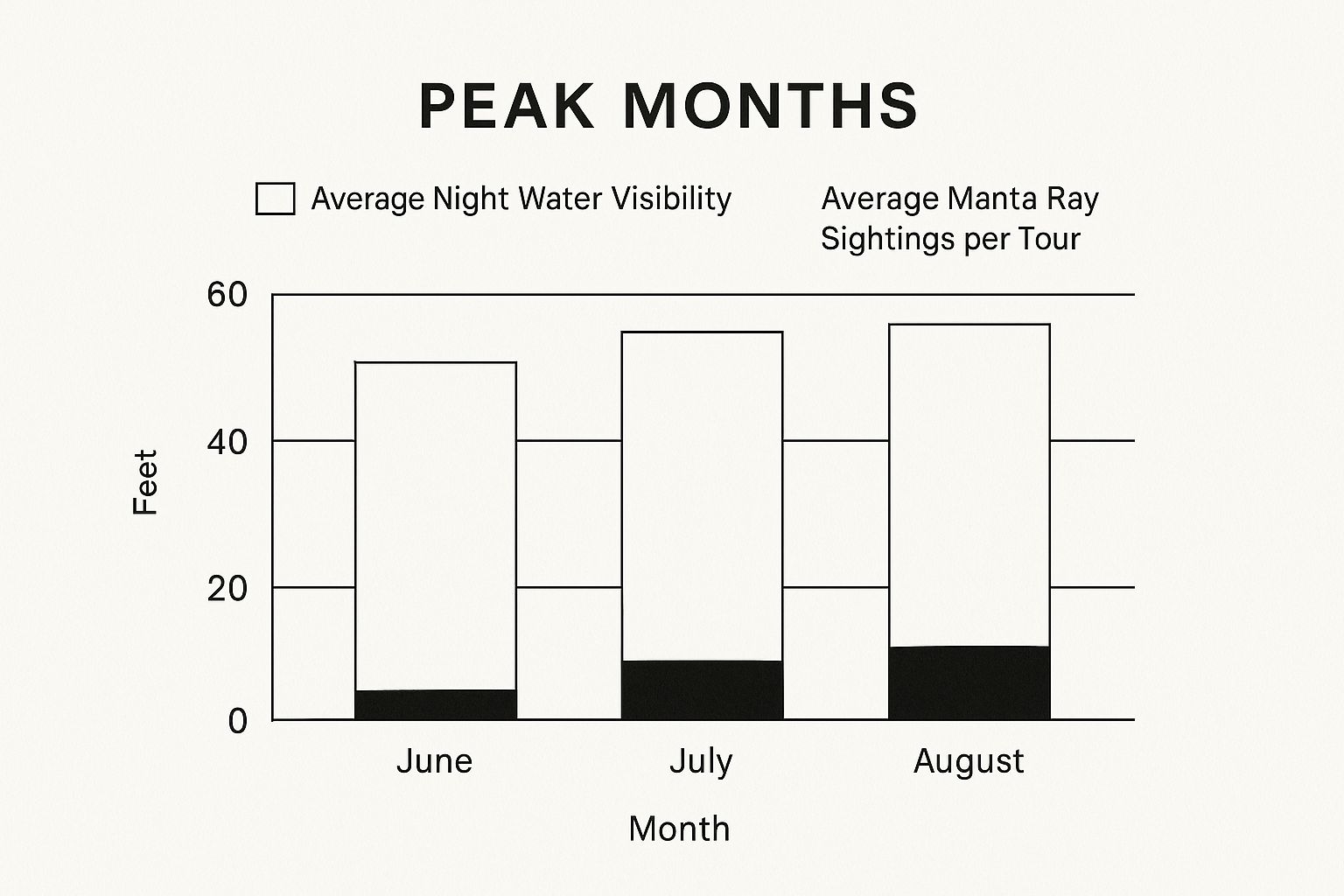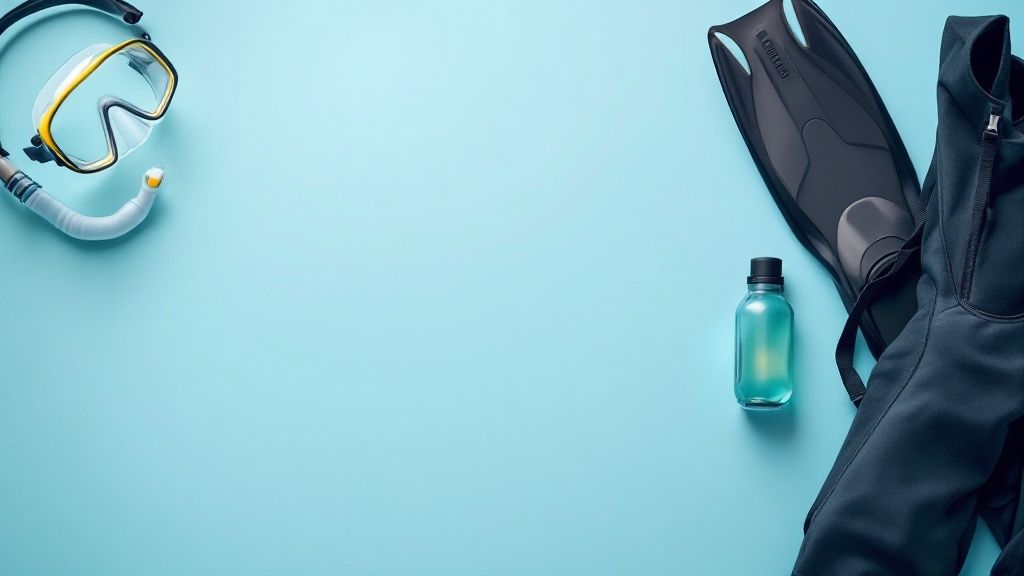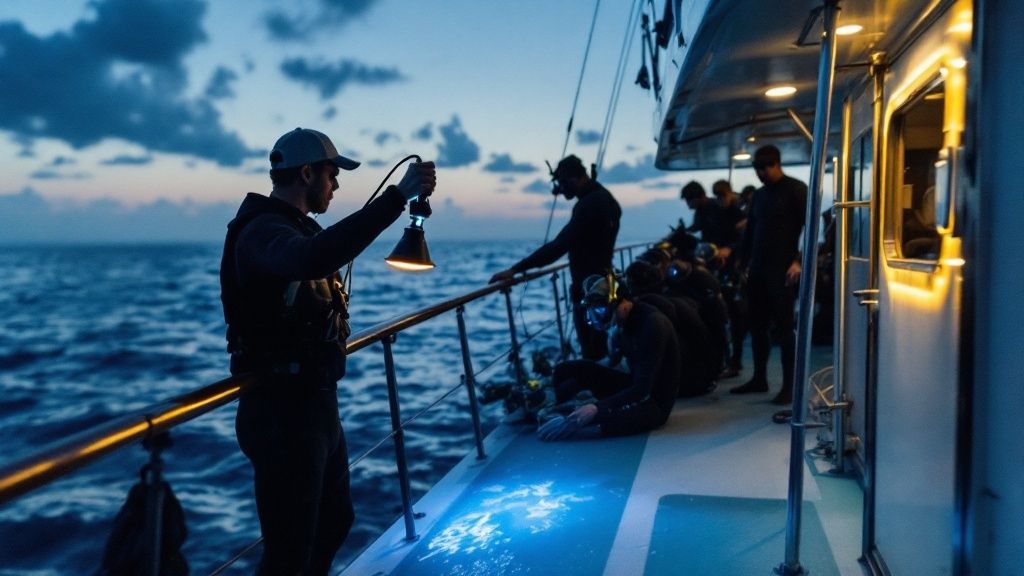Manta Ray Snorkel Kona | Unforgettable Hawaii Marine Tours
- Byron
- May 20
- 13 min read
The Magic of Manta Ray Encounters in Kona Waters
Floating in the dark ocean, with only the soft glow of underwater lights, is an experience unlike any other. As massive manta rays glide beneath you, it's clear this isn't just a snorkel trip; it's a truly captivating wildlife encounter that has become synonymous with Kona, Hawaii. It sets a new standard for marine life experiences, offering a unique blend of adventure and a sense of wonder.
Why Kona's Mantas Are Uniquely Special
The magic starts with the sheer size and elegance of these gentle giants. With wingspans reaching up to 12 feet or more, they resemble underwater spaceships, navigating the depths with balletic grace. Unlike other locations, Kona's resident manta ray population offers an almost guaranteed encounter. This reliability, coupled with the unique nighttime setting, builds an atmosphere of anticipation and excitement. Picture yourself suspended above the ocean floor, looking up as these incredible creatures perform their mesmerizing feeding rituals.
Manta ray snorkeling in Kona, Hawaii, is world-renowned, attracting approximately 80,000 participants annually. This popularity is driven by the high likelihood of seeing manta rays in their natural environment, boasting a remarkable sighting success rate between 80% and 90%. This means roughly 8 to 9 out of 10 snorkelers are likely to see manta rays during their trip. More detailed statistics can be found here: Manta Ray Snorkeling Kona: Unforgettable Encounters
Addressing First-Timers' Concerns
First-time snorkelers often have questions. "Is it safe?" Absolutely. Despite their size, manta rays are filter feeders, lacking stingers or barbs. They pose no threat to humans and are often curious and even seem playful. "Will I actually see mantas?" The impressive sighting success rate speaks volumes. This consistency helps ensure most snorkelers will have a face-to-face experience with these amazing animals. "What makes Kona so special?" Kona offers a unique blend of nutrient-rich waters, predictable manta ray feeding patterns, and responsible tour operators committed to both guest satisfaction and manta ray conservation. This balance ensures a sustainable and enriching experience for everyone involved.

You might be interested in: Manta Ray Night Snorkel Kona: Unforgettable Adventure
From Nervous Excitement to Transformative Awe
The emotional journey of a manta ray snorkel is just as extraordinary. It starts with the nervous thrill of entering the dark ocean. But as the first manta ray gracefully glides into view, any anxiety transforms into pure wonder. This powerful experience stays with visitors long after they leave the water. Even experienced ocean enthusiasts often consider these encounters among life’s most magical moments, a testament to the deep connection these gentle giants inspire. It's more than just seeing wildlife; it's feeling a profound link to the natural world.
Prime Manta Ray Hotspots: Where Magic Happens Nightly
Not all manta ray snorkel Kona experiences are created equal. Knowing where to go significantly impacts your encounter with these graceful giants. Two spots reign supreme as Kona's legendary manta ray viewing locations: Keauhou Bay, affectionately known as Manta Village, and Garden Eel Cove, sometimes called Manta Heaven. Understanding the unique characteristics of each is key to an unforgettable experience.
Keauhou Bay: Manta Village
Keauhou Bay boasts a unique underwater landscape perfect for manta ray feeding. The shallow, sandy bottom, combined with the hotels lining the shore, inadvertently created this hotspot. Hotel lights attract plankton, the manta rays' main food source, and the mantas reliably follow. This consistent food supply makes Keauhou Bay a dependable location for manta ray snorkel Kona tours. Want to learn more about these incredible encounters? Check out: Night Manta Ray Snorkel Kona.
Garden Eel Cove: Manta Heaven
North of Kona lies Garden Eel Cove, another prime manta ray viewing location. While also rich in plankton, Garden Eel Cove differs from Keauhou Bay in its currents and depth. The cove is generally deeper and experiences stronger currents, which can influence water clarity and manta ray behavior. Experienced captains often choose between the two locations based on real-time conditions and recent sightings. For instance, calmer Keauhou Bay might be preferred on nights with rougher seas.
Peak Season Insights
To help you plan your adventure, we've compiled a comparison of the top manta ray snorkeling locations in Kona. The table below details key factors to consider when choosing the best spot.
Manta Ray Snorkel Locations in Kona A comparison of the primary manta ray snorkeling locations in Kona, helping visitors choose the best spot for their adventure
Location | Average Sighting Rate | Best Time to Visit | Special Features | Depth |
|---|---|---|---|---|
Keauhou Bay (Manta Village) | High (due to consistent plankton from hotel lights) | Year-round, especially summer months | Shallow, sandy bottom; calm waters | Relatively shallow |
Garden Eel Cove (Manta Heaven) | High (naturally occurring plankton) | Year-round, conditions dependent | Deeper water; stronger currents; can offer different manta behaviors | Deeper than Keauhou Bay |
As you can see, both locations offer excellent viewing opportunities. Keauhou Bay is known for its consistent sightings and calm waters, while Garden Eel Cove offers a potentially more dynamic experience with varying manta ray behaviors due to the deeper water and currents.
The infographic below visualizes peak season data for average night water visibility and manta ray sightings per tour in June, July, and August.

As the infographic shows, July typically provides the best visibility and highest number of manta ray sightings, making it a prime time for your Kona adventure. While June and August also offer fantastic opportunities, July often presents ideal conditions. Looking for more tips and insights? Check out this helpful resource: Manta ray snorkel Kona: top tips & best spots. Choosing the right spot and timing enhances your chances of a truly memorable manta ray experience.
The Fascinating Science Behind Night Manta Encounters
Manta rays appearing in Kona's waters with almost clockwork precision isn't magic. It's a fascinating display of ecological interplay. This predictable phenomenon revolves around a complex relationship between artificial light, plankton, and the manta rays' feeding habits. Marine biologists studying these creatures have uncovered intricate details about this underwater dance. The specialized underwater lighting used by tour operators plays a crucial role.
These lights attract massive amounts of plankton, the manta rays' primary food source. This concentrated feast draws the mantas, creating a predictable and spectacular feeding display. The giant manta rays spotted in Kona can have wingspans exceeding 12 feet, making these graceful creatures unforgettable to observe. Snorkeling tours typically take place at popular locations such as Keauhou Bay and Manta Village. Nutrient-rich ocean currents in these areas attract abundant plankton, creating ideal feeding conditions. Tour operators enhance these feeding grounds with specialized underwater lighting, further attracting plankton and, consequently, the manta rays. Learn more about manta ray feeding here. This understanding of manta ray behavior allows for responsible and sustainable manta ray snorkel Kona tourism.
Manta Intelligence and Interactions
The remarkable intelligence of manta rays further enhances the magic of these encounters. They possess the largest brain-to-body ratio of any fish. This high intelligence translates to curious and sometimes even playful interactions with snorkelers. But these gentle giants are more than just a spectacle. They are subjects of ongoing scientific study, meaning each encounter contributes to our understanding of these magnificent creatures.
Researchers use unique markings on each manta's belly, much like fingerprints, to identify individuals. This allows them to track movements, study social behaviors, and gain valuable insights into their complex lives. Coupled with long-term observation, these identification efforts reveal fascinating details about manta ray social structures, migration patterns, and individual personalities. Manta Ray Snorkel Kona: Experience Hawaii's Greatest Adventure. These discoveries enrich our understanding of manta ray life beyond the mesmerizing feeding displays.
Balancing Tourism and Conservation

The success of manta ray tourism in Kona depends on a delicate balance. It requires providing unforgettable experiences while simultaneously protecting these vulnerable creatures. Responsible operators are crucial for maintaining this balance. They adhere to strict guidelines regarding interaction with the mantas, ensuring minimal disturbance to their natural behaviors. This mindful approach ensures the long-term health of the manta ray population while still allowing visitors to witness their beauty up close. This collaborative effort between tourism and conservation ensures future generations can marvel at these gentle giants.
The growth of manta ray tourism has also fueled important research and conservation efforts. Revenue generated from these tours often directly supports projects focused on understanding and protecting manta rays. These initiatives range from tagging and tracking studies to habitat preservation and educational programs. The combined efforts of researchers, tour operators, and visitors are essential for safeguarding the future of these incredible animals.
Selecting Your Perfect Manta Ray Experience
With so many tour operators offering manta ray snorkel Kona experiences, choosing the right one can be a challenge. How can you tell the truly great tours from the average ones? We'll help you cut through the noise and understand what really matters when booking your manta ray adventure.
Key Questions To Ask When Booking
Speaking with marine biologists and experienced guides highlighted some key questions to ask potential tour operators. Don't just look at the price; consider these crucial factors:
Boat Design and Comfort: A stable and spacious vessel significantly improves your overall experience, especially on evening tours. Ask about the type of boat and its amenities.
Group Size: Smaller groups often result in more personalized interactions with the mantas and more attention from the guides. Find out the average number of guests on each tour.
Guide Expertise: Seek out guides with a deep understanding of manta ray behavior and the local marine ecosystem. Their knowledge can greatly enrich your experience.
Conservation Commitments: Opt for operators dedicated to sustainable practices and the well-being of the manta rays. Inquire about their conservation efforts and responsible guidelines.
The Price Vs. Quality Equation
While budget-friendly options are attractive, remember that a lower price may mean a compromised experience. Overcrowded boats, less experienced guides, and limited time in the water can detract from the magic of encountering these gentle giants. Premium pricing often (but not always) means smaller groups, better equipment, and a focus on responsible tourism. Careful research and comparison are essential.
To help you in your research, we've compiled a helpful comparison table outlining the different tour types available:
To help you choose the perfect manta ray snorkel tour, we've created a comparison table outlining key differences between the various options.
Manta Ray Snorkel Tour Comparison
A detailed comparison of different tour types to help visitors select the best manta ray snorkeling experience for their preferences and needs.
Tour Type | Average Group Size | Price Range | Duration | Inclusions | Best For |
|---|---|---|---|---|---|
Small Boat Tour | 6-12 | $150-$200 | 2-3 hours | Snorkel gear, wetsuit, guide, light refreshments | Those seeking a more intimate and personalized experience |
Large Catamaran Tour | 20-40 | $100-$150 | 2-3 hours | Snorkel gear, wetsuit, guide, buffet dinner | Families and larger groups looking for a comfortable and social experience |
Zodiac Raft Tour | 10-16 | $175-$225 | 2-3 hours | Snorkel gear, wetsuit, guide, dry bags | Adventurous snorkelers seeking a thrilling ride |
Private Charter | Customizable | $500-$1000+ | Customizable | Customizable based on needs | Families, groups, or individuals looking for a fully customized and exclusive experience |
This table provides a general overview, and specific offerings can vary between operators. Be sure to check individual tour details for the most up-to-date information.
Choosing the right tour type can significantly impact your overall experience. Consider your budget, group size, and desired level of adventure when making your selection.
Check out our guide on Manta Ray Snorkel Kona: Top 2025 Tours for more in-depth tour comparisons.
Vessel Types and Viewing Opportunities
Different boats offer various levels of comfort and viewing opportunities. Larger catamarans provide stability and plenty of deck space, while smaller boats can navigate different areas. Consider your preferences and any concerns about seasickness when choosing a vessel type. Some operators even offer unique experiences like zodiac tours for a more adventurous ride.
Equipment and Comfort Factors
The right equipment significantly impacts your comfort in the water. A properly fitted wetsuit of appropriate thickness is essential for warmth during the night snorkel. High-quality masks and snorkels ensure clear visibility and easy breathing. Ask about the provided gear and bring your own if you have specific preferences.
Recognizing Responsible Operators
Look for subtle signs that an operator prioritizes both guest satisfaction and manta ray well-being. These include limiting group size, adhering to established guidelines for manta ray interactions, and participating in conservation efforts. Choosing a responsible operator ensures a memorable and enriching experience for both you and the majestic manta rays.
Kona's Manta Legacy: Conservation Through Connection
The story of manta ray snorkel Kona is more than just a thrilling tourist attraction. It's a powerful example of conservation through connection. What started as an unexpected discovery in the early 2000s quickly became a cornerstone of marine conservation, turning casual tourists into passionate manta ray advocates. This shift highlights the significant impact of responsible wildlife tourism. Manta ray snorkeling in Kona began when local dive operators realized the unique opportunity to offer nighttime snorkeling experiences with these gentle giants.
Since then, the practice has exploded in popularity. Detailed sighting statistics have been tracked annually since 2009. Data from various years consistently show sighting rates above 80%, confirming Kona as a manta ray hotspot. Find more detailed statistics here: Manta Ray Statistics.
Pioneering Sustainable Practices
Through conversations with pioneering operators and researchers, the story of how sustainable practices took root unfolds. Early operators quickly understood the importance of minimizing human impact on the mantas and their surroundings. This led to the development of strict guidelines. These guidelines included no-touch policies and specific procedures for boat positioning and lighting.
Managing the growing popularity of manta ray snorkel Kona tours, however, presented a new set of challenges. Balancing the demand for these incredible experiences with the need to protect the mantas became a top priority.
Identification: Unveiling Individual Stories
A groundbreaking aspect of the Kona manta ray program is its innovative identification system. Researchers and operators carefully track individual mantas by their unique belly patterns, similar to fingerprints. This detailed record-keeping has allowed them to catalog over 250 individual mantas, each with a name and a distinct personality. Learn more in our article about Manta Ray Snorkel Kona: Unforgettable Ocean Encounters.
This long-term tracking reveals fascinating details about their life histories, migratory patterns, social interactions, and even individual quirks. Some mantas are known for playful interactions with snorkelers, while others are more shy.
From Tourism to Conservation Funding
One of the most inspiring parts of the Kona manta ray story is how visitor participation directly supports conservation. Revenue generated from manta ray snorkel Kona tours funds vital research projects and habitat protection. Every visitor contributes directly to the well-being of these amazing creatures.
This conservation model thrives because it fosters emotional connections, not just educational awareness. By experiencing the magic firsthand, visitors become invested in the mantas' future, transforming from tourists into lifelong advocates. This connection, built through the wonder of a close encounter, proves that responsible tourism can be a powerful force for conservation.

Preparing For An Unforgettable Manta Encounter
Transforming your manta ray snorkel Kona experience from simply "good" to truly unforgettable requires a bit of insider knowledge. Beyond the typical packing list, understanding a few subtle techniques can maximize both your comfort and your chances of close encounters with these gentle giants.
Choosing The Right Gear
Getting the gear right is the first step towards an amazing experience. A wetsuit is crucial for staying warm in the cool night waters. The ideal thickness depends on the season, but a 3mm or 5mm wetsuit is usually recommended. Additionally, a well-fitting mask and snorkel are essential for clear vision and effortless breathing. Don't forget a defogger for your mask; the temperature difference between the air and water can cause fogging.
Mastering Ocean Comfort
Evenings on the water can sometimes be choppy. If you're prone to seasickness, consider taking non-drowsy motion sickness medication an hour or two before your tour. When preparing for your manta encounter, consider the impact of your choices; learn more about sustainable takeout packaging. Staying hydrated is also key to managing seasickness and overall comfort in the ocean environment.
Positioning For The Perfect View
Once in the water, the best viewing position is typically floating on the surface, holding onto a provided flotation device. This allows the manta rays to swim freely beneath you. Resist the urge to dive down or chase them; let these graceful creatures come to you. Remember, touching the manta rays is harmful to them and strictly discouraged by responsible tour operators.
Capturing The Magic In Low Light
Photographing manta rays in low light can be a challenge. Consider using a waterproof camera with good low-light capabilities or an underwater housing for your phone. If using a flash, opt for a red filter to minimize disturbance to the mantas and enhance the natural beauty of their underwater world.
Mental Preparation And Lunar Cycles
For some, the thought of entering dark ocean water can be a bit daunting. Remember, manta rays are gentle giants and pose no threat to humans. Focus on the incredible opportunity to witness these magnificent creatures up close. Interestingly, the lunar cycle can affect visibility and manta ray behavior. A full moon can make the water appear brighter, while a new moon can enhance the effect of the underwater lights attracting plankton. Consider this when planning your trip.
Considerations For All Snorkelers
Manta ray snorkel Kona tours cater to a wide range of abilities. If you're a less confident swimmer, a life vest will be provided. Tour operators are experienced in assisting snorkelers of all skill levels. Be sure to communicate any concerns or limitations to your guide beforehand. Families with young children or older adults should choose operators with experience in catering to these age groups, ensuring everyone can fully embrace this magical experience.
Becoming Part of the Manta Conservation Community
Your manta ray snorkel Kona adventure doesn't have to end when you climb back on the boat. In fact, it can be the beginning of a lifelong journey as a manta ray advocate. Through citizen science initiatives, visitors are making significant contributions to research and conservation efforts, transforming a magical experience into something truly meaningful.
Contributing Through Citizen Science
One of the most exciting ways to stay involved is through photo identification. Every photo you snap of a manta's unique belly markings could help identify a previously undocumented individual. These markings are like fingerprints, and researchers use them to track manta movements, understand their social structures, and study their life histories.
Your snapshots might just be the key to unlocking new discoveries. Additionally, tracking programs allow you to follow “your” manta for years after your visit, fostering a lasting connection with these magnificent creatures. Imagine being able to follow the life journey of a manta you encountered years later, contributing to valuable long-term research.
Community-Powered Research: Revolutionizing Manta Understanding
Community-powered research has dramatically changed our understanding of manta rays. For example, data collected by visitors has helped researchers map migration patterns, understand their reproductive behaviors, and uncover surprising details about their intelligence and social interactions. This collaborative approach has proven far more effective than traditional research methods alone.
This collaborative approach not only provides researchers with a much larger data pool but also creates a sense of shared responsibility in protecting these gentle giants. The impact of this eco-tourism is significant, not only in terms of recreation but also in promoting manta ray conservation and awareness. Through the documentation and tracking of individual mantas, over 250 have been catalogued by researchers and operators in the area.
This makes Kona one of the top destinations globally for manta ray encounters, combining memorable wildlife experiences with responsible tourism practices. Find more detailed statistics here: Manta Ray Snorkeling Kona: Unforgettable Encounters
Supporting Global Manta Protection
Your manta ray snorkel Kona tour also contributes to a larger network of manta protection initiatives. Many responsible operators donate a portion of their proceeds to organizations dedicated to manta research and conservation. This financial support helps fund critical projects around the world, extending the positive impact of your experience far beyond Hawaii's waters.
This global collaboration helps improve understanding of manta behavior and promote conservation efforts internationally.
Hawaii's Conservation Model: A Global Inspiration
Hawaii's success in balancing tourism with manta ray protection is being replicated globally. The identification programs, responsible tour operator guidelines, and community-powered research initiatives developed in Kona are now being adapted in other manta hotspots. This sharing of best practices ensures that the positive impacts of manta tourism benefit these vulnerable creatures worldwide.
Staying Connected Long After You Leave
Your involvement doesn't end with your trip. Many organizations offer ways to stay connected, including newsletters, online communities, and volunteer opportunities. You can continue learning about ongoing research, follow the latest conservation news, and even contribute to ongoing data analysis. These opportunities offer meaningful ways to support manta protection long after you return home.
Experience the magic of manta rays and become a part of their future. Book your Manta Ray Night Snorkel Kona Hawaii Tour today and start your own conservation journey!
Comments